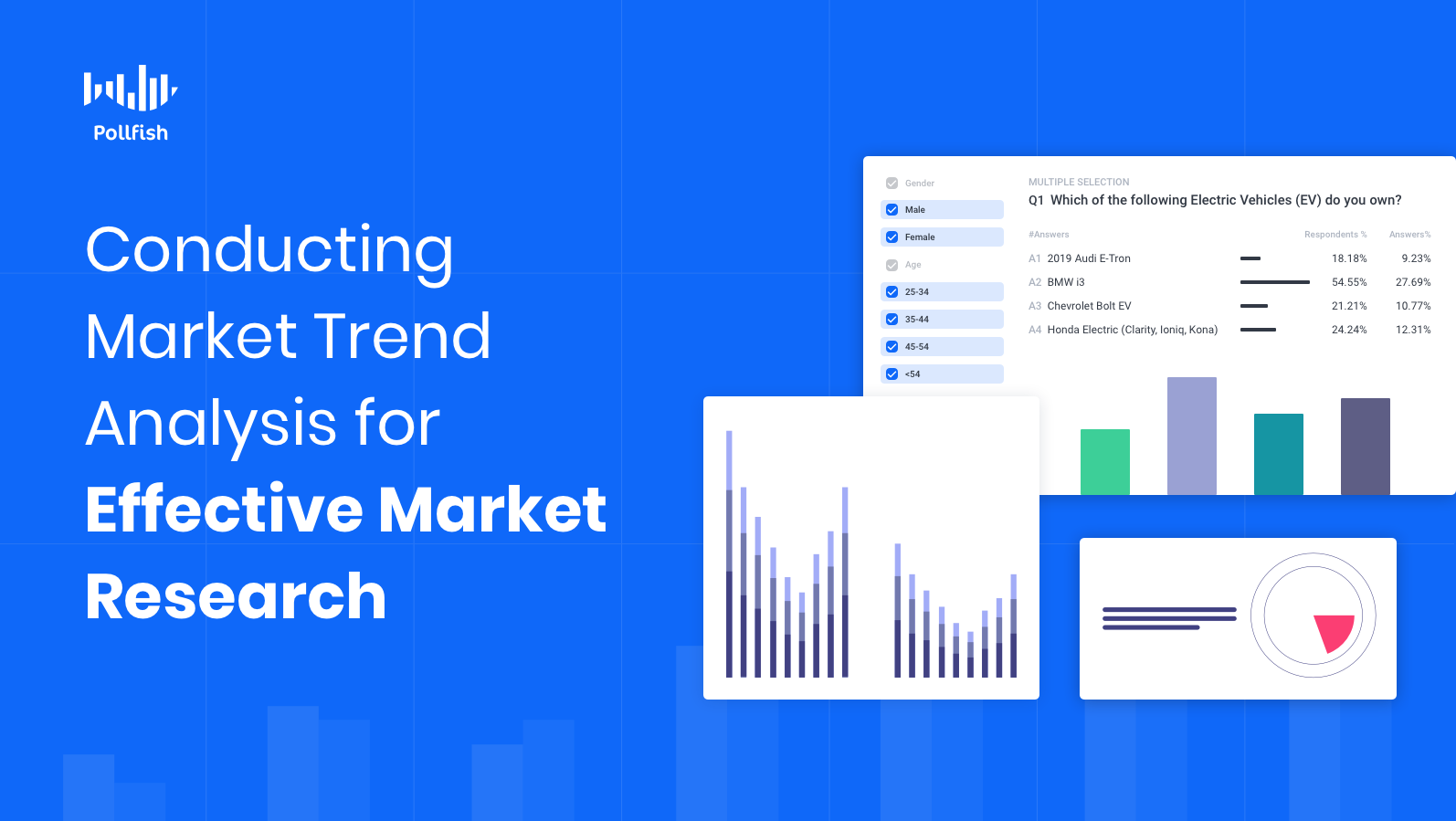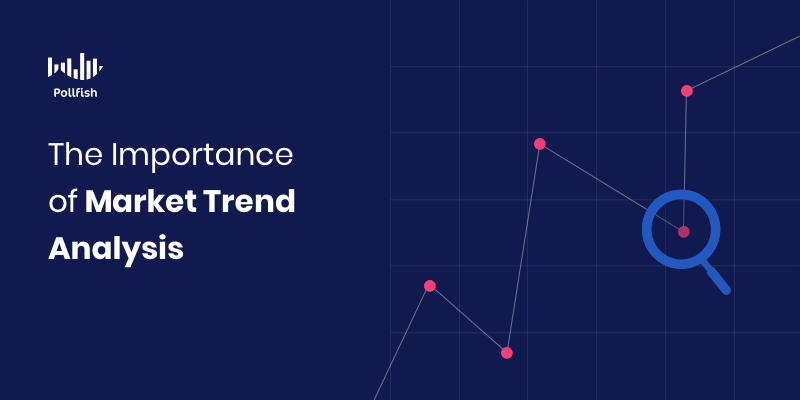How to Conduct a Market Trend Analysis for Sublime Market Research

Conducting a market trend analysis is critical for a market research campaign, as it uncovers trends in both an industry and within a target market — the group of customers most likely to purchase from a company.
Market trend analysis is valuable for data-driven decision-making, as it consolidates trends extracted from data and puts them and their key aspects, such as customer behavior, for example, into perspective. In turn, this helps businesses recognize patterns and make predictions on various strategies and campaigns, along with discovering future trends.
Additionally, although trend analysis is chiefly used in the financial sector, its concept is also essential to market research, as it is used to make sense of survey data analysis, allowing researchers to understand their findings, thereby improving the market research process.
This article explores market trend analysis, why businesses must conduct it, how to conduct it for efficient market research and more.
Understanding Market Trend Analysis
A market trend analysis is a kind of trend analysis, except rather than focusing on the financial aspects of a sector or business, it refers to analyzing trends in a market or industry at large.
Specifically, a market trend analysis is a method of analysis on past and current market behavior, along with dominant patterns of the market and its consumers. This kind of analysis relies on examining statistical data and recorded market behavior over a defined period of time.
This kind of analysis covers a wide range of topics, as trends can appear within different aspects of a market.
Businesses, therefore, use this kind of analysis to extract necessary information in order to map out and support the strategic planning process and forecast future trends within customers, campaigns and other business plans.
Identifying the prominent traits of an industry and its target market, this kind of analysis acquaints businesses with key occurrences in the market, thus it is a vital practice in market research.
The Importance of Market Trend Analysis

Market trend analysis carries significant weight in market research, for a number of reasons, including the ones aforementioned.
First off, one of the greatest concerns in a business and virtually any entity is that of performance. A market trend analysis grants insights on performance, identifying areas of sufficient business performance, along with those that aren’t faring well.
Thus, it helps businesses on the decision-making front, providing insights that boost long-term strategy and helping businesses avoid future setbacks.
Given that in market research, trend analysis is used to better understand consumers, this kind of analysis provides insights into customer behavior trends, allowing businesses to cater to customers with data backing all of their decisions. This way, customers are more likely to engage with brand campaigns and make purchases.
Moreover, market trend analysis can obtain valuable insights into the overall scenario of a market. For example, a SaaS company can discover the products, services and startups within a particular niche of their industry.
Alternatively, a shoe brand can discover the latest trends in shoe designs and fashions by running various market research campaigns that capture customer sentiment, opinions, preferences and recognition of shoe brands and styles.
Market trend analysis also helps businesses gain an understanding of their market’s macro-environment, the holistic condition existing in an economy, rather than a specific sector of it.
Conducting trend analysis helps businesses find and display long-term data in summary form. The data can be used to investigate changes across different points in time and find how both customers and markets respond to them.
These variations can involve changes in demand levels in the market, allowing businesses to take appropriate action, as periods of high demand and low demand require different strategies.
What Businesses Can Learn with Trend Analysis
Businesses can gain the various insights laid out above. In terms of market research, these insights provide information about three key aspects: customer preferences, the macroeconomic environment (market’s economy at large) and changes in the industry.
With the trend analysis report, you can compare historical data and get answers to questions like:
In market trend analysis report, businesses can understand the following:
- Changes in their NPS score over a period of time
- Levels of employee engagement and turnover
- Sales fluctuations and forecasts
- Change in customer experience in the past year
There are various other market aspects that businesses can examine with this kind of analysis. In addition, businesses can plan their actions in response to long-time or emerging trends and any changes in their market. As such, trend analysis prepares businesses for the long term.
The Different Types of Market Trend Analyses

There are four main types of market trend analyses that businesses and market researchers should acquaint themselves with. The following explains the four kinds, so that businesses can aptly conduct a market trend analysis and analyze it based on the categories.
- Consumer Trend Analysis:
- This focuses on trends among a target market, its segments and customer personas.
- It involves gathering key customer data such as customer satisfaction, customer aversions, needs, opinions, preferences, customer buying behavior and more.
- This involves studying product trends in relation to customers’ reception and opinions of them.
- Historical Trends Analysis:
- This is an investigation into past industry trends in a market or niche.
- It shows researchers how such trends developed, how they affect the present and how they will affect the future.
- Historical trends concern historical data, which can date back years, along with data from the near past, such as the past few days, weeks and months.
- In this kind of trend analysis, there is typically a comparison between the current market with others, such as year-by-year or period-by-period analysis.
- Seasonal and Temporal Trend Analysis:
- This is an analysis of market shifts relating to seasonal events, such as holidays, the weather, natural disasters, etc.
- Many of these are recurrent, such as the holiday season, which starts around late November and lasts through most of December. For businesses, strategizing for this season occurs many months in advance, thus the data they use tends to be historical trends analysis.
- Geographic Analysis:
- This entails studying trend changes based on geographic location.
- These analyses can include comparisons between different regional areas within a country, or on an international basis, studying trends from different countries and even continents.
- It involves conducting global market research, should the trend analysis delve into international markets.
- This analysis seeks to discover how trends develop in geographies of various sizes and places.
How to Conduct Market Trend Analysis to Excel in Market Research
There are various means to run such an analysis and businesses can complete this with a process for collecting, comparing and analyzing data.
The following explains how to conduct market trend analysis in a step-by-step process.
- Determine the trends you seek to study for your trend analysis. To do so, refer to the above section on the major different kinds of market trend analyses. You can also perform a social media and desktop versus mobile analysis, should your business require it.
- Create a focus on your trend analysis within the main topic you chose. For example, if you choose to analyze consumer trends, consider the major aspects of consumers that you ought to focus on for your study. This will differ from business to business.
- For example, you can study their reactions to your ads and marketing messages, their purchasing behaviors, their preferences, etc.
- Pinpoint your target population of study. You can also begin broadly, by targeting the entirety of your target market.
- Conduct secondary research in regards to your target market and the focus of the study.
- There are various online sources to consult, such as trade publications, news sites, sites dedicated to your niche, statistics websites, etc.
- Stay up to date with industry research and trends reports. There are various online sources offering these reports, such as IBISWorld.
- Study your competition. Observing your competitors gives you a good picture of their market positioning and how they react to an emerging trend.
- Conduct primary research around the focus of your trend analysis. There are various methods and digital tools that can be used to extract primary data. Survey research is among the strongest, as it powers its users to inquire into any topic, form and ask any question, along with distributing the survey to its intended audience.
- Find the correct online survey platform to conduct your primary trend analysis research. A strong tool is user-friendly, offers deployment on a vast network of popular websites and apps, offers global support, uses random device engagement (RDE) sampling and more.
- Analyze all of your findings by studying both primary and secondary resources. Specifically, look for patterns and repeated actions, opinions, etc.
- Based on your analysis, identify all possible trends, both minor and major. Create a document based on these findings.
- Put your analysis into action. If you are able to successfully discover trends, create a plan of action based on them. Your plan of action can include new campaigns or changes to current campaigns, changes to your strategy or changes to how you engage your topic of study, in this case, the customers.
- You ought to conduct more survey research should your analysis appear to be lacking, if it leads to further questions or if you simply need to understand your trends at a more granular level.
Powering Each Market Research and Trends Project
Conducting a market trend analysis is a crucial factor in maintaining strong market research campaigns. Aside from uncovering trends among customers, market segments and the market at large, this kind of analysis complements any market research endeavor, with key, organized data.
While there are various means of performing market trend analysis, survey research helps carry this kind of analysis, as it empowers researchers to inquire into virtually every business subject, from purchases, to buying habits, to brand recognition and much more.
As such, the proper online survey platform will unlock various trends, but businesses must choose one wisely, as they are not all built the same. A strong online survey platform will enable businesses to deploy a massive volume of surveys across a multitude of digital websites and apps, hyper-target customers and take a few days at most to complete.
The Pollfish online survey platform offers all of these capabilities, including an RDE (random device engagement) method to draw responses from digital users voluntarily, bias-free and in their natural environments.
Pollfish Marketing Team
Ready to Try Pollfish?
Create your survey with AI, target high-quality respondents starting at $0.95 per complete, and start getting results in just minutes in real-time. From running a simple product concept survey to managing a constant stream of trackers for dozens of clients in dozens of countries, we’ve got you.
